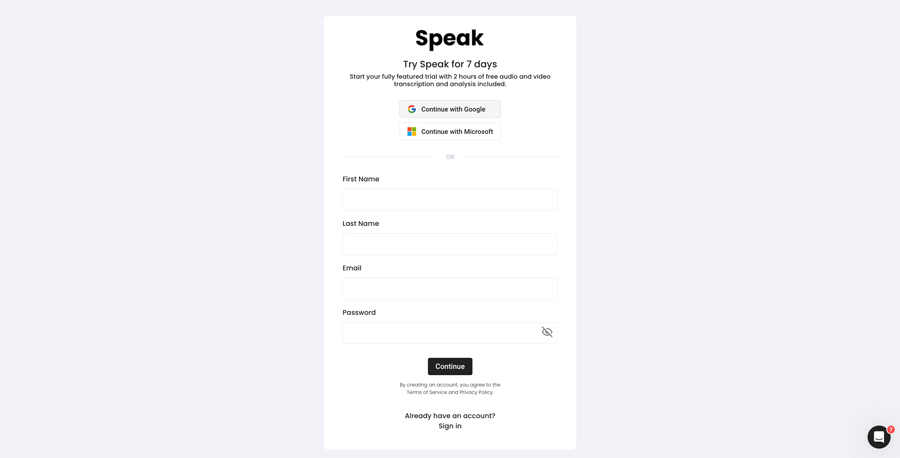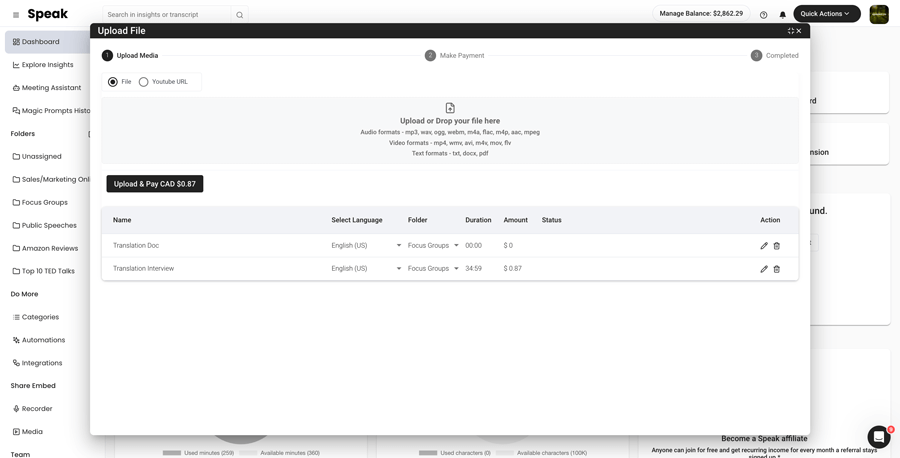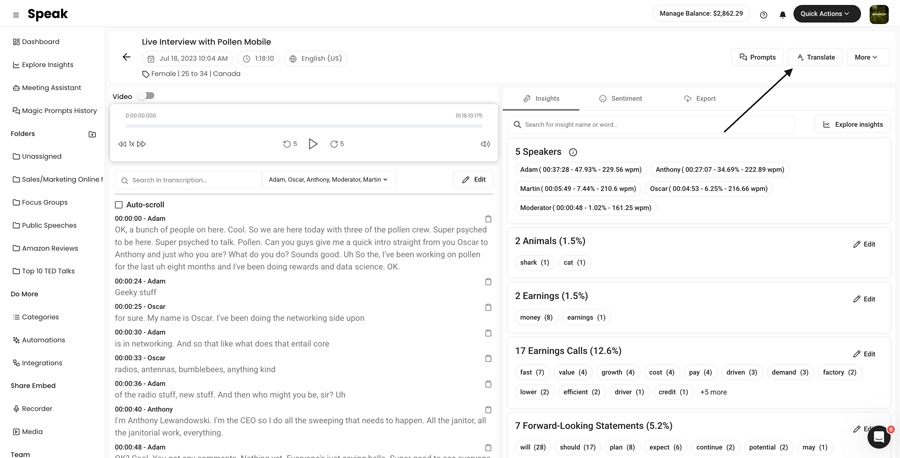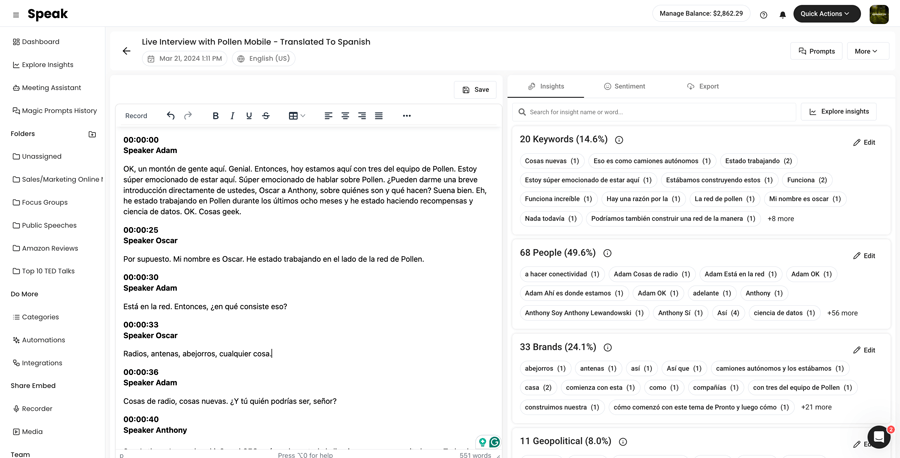How To Translate Japanese to Farsi (Persian)
Translating Japanese to Farsi (Persian) is super simple!

Step 1: Register for Speak
Register for Speak using this link.
Once you register, you can instantly begin translating your Japanese to Farsi (Persian) file(s).

Step 2: Upload Your Japanese file(s)
As soon as you log in, you will be redirected to the dashboard.
Once there, you can select the Quick Action "New Upload".
In Speak, you can seamlessly upload, transcribe and translate audio, video and text files all at once!

Step 3: Translate Your Japanese file(s) to Farsi (Persian)
Once the file is uploaded, simply visit your file and select "Translate".
If it is an audio and video file, Speak will ask you if you want to keep the speaker names and timestamps in the translation.
Want to translate many files at once? No problem!
You can view the files you want to automatically translate from Japanese to Farsi (Persian) from the folder level and instantly translate as many files as you need with our artificial intelligence translation in just a few clicks.

Step 4: That's It! View, Analyze, Modify & Export Your New Farsi (Persian) file(s)
Once the translation is done, you will be alerted and you will see a new document in the same folder your original file is in.
The file will be named the same but with a dash indicating that it is the translated version.
Need support with your Japanese translation?
We are always here and happy to help at Speak!
Just send us a message on live chat on the bottom right corner and we will ensure you are set up for success.
Interested in translating Japanese or other languages to different languages? View our entire list of supported translation languages here.
Automatic, accurate, instant AI translation from Japanese to Farsi (Persian) is here for you.
Register for Speak using this link and begin translating Japanese to Farsi (Persian) today.
Unlocking New Horizons: Translate Japanese to Farsi (Persian) with AI
Embarking on the journey of translating Japanese to Farsi (Persian) opens up a world of opportunities that span cultural insights, business expansions, and academic research. With technological advancements, particularly in artificial intelligence (AI) and natural language processing (NLP), the task of translating between these linguistically distinct languages has become more accurate and efficient. Speak AI, a frontrunner in the realm of AI-driven solutions, is at the forefront of revolutionizing how we approach translations. Our integrated NLP, large language models, data visualization, generative AI, and our AI Meeting Assistant stand ready to transform your multilingual communications.
The Value of Japanese to Farsi (Persian) Translation
Understanding the immense value embedded in translating content from Japanese to Farsi (Persian) leads to recognizing the diverse applications and benefits it brings. Businesses looking to expand in Japanese or Persian-speaking markets, researchers diving into socio-cultural studies, and content creators aiming to reach a wider audience, all stand to gain from accurate and nuanced translations facilitated by AI technology.
Benefits for Businesses and Researchers
Businesses venturing into new markets and researchers conducting cross-cultural studies can leverage AI-powered translations to overcome language barriers efficiently. The key benefits include:
- Expanded Reach: Access broader audiences or research subjects by presenting your content in their native language.
- Increased Accuracy: AI and NLP technologies ensure translations maintain the original message's integrity, crucial for business contracts and academic research.
- Cost and Time Efficiency: Automatic translations significantly reduce the time and expense associated with traditional translation methods, streamlining communications and research processes.
Optimizing Media Content
For media content, whether it's audio, video, or text, translating from Japanese to Farsi (Persian) and vice versa has never been simpler. Speak AI’s tools automatically transcribe and translate content, enabling creators to produce multilingual versions of their work effortlessly, thereby enhancing viewer engagement and satisfaction.
Empowering Global Communication
Speak AI's suite of tools, including our pioneering AI Meeting Assistant that integrates with platforms such as Microsoft Teams, Zoom, Google Meet, and Webex, simplifies the process of translating meetings, webinars, and conference calls. This technology not only bridges language gaps but also democratizes information, making it accessible to a global audience.
Exploring Japanese and Farsi (Persian) Landscapes
Before delving into the technical realm of translation, let's explore the cultural and linguistic landscapes of Japanese and Farsi (Persian) languages, highlighting their significance, historical backgrounds, and fun facts.
Geographical and Statistical Insights
Japanese is predominantly spoken in Japan, with over 125 million native speakers, while Farsi (Persian) is primarily spoken in Iran, Afghanistan (as Dari), and Tajikistan (as Tajiki), boasting around 110 million speakers globally. These languages not only represent their respective cultures but also serve as a bridge connecting their rich histories and traditions across continents.
Fun Facts about Japanese and Farsi (Persian)
- Japanese incorporates a complex writing system, including Kanji, Hiragana, and Katakana, whereas Farsi uses a modified version of the Arabic script.
- Farsi (Persian) has remained relatively unchanged for over a millennium, making works of literature from centuries ago still comprehensible to modern speakers.
Differences and Similarities
Despite their geographical and script differences, Japanese and Farsi share linguistic features, such as the extensive use of honorifics, which reflect social hierarchies within their cultures. However, the structure of the languages diverges significantly, with Japanese being an agglutinative language and Farsi following a subject-object-verb (SOV) order.
Conclusion: Shaping the Future with AI Translation
Translating between Japanese to Farsi (Persian) is not just about converting text from one language to another; it’s about creating bridges of understanding and opening avenues of knowledge. With Speak AI's cutting-edge technology, businesses, researchers, and content creators can now navigate these linguistic landscapes with ease and efficiency. At Speak AI, we’re not just developing tools; we’re fostering connections, enabling growth, and pushing the boundaries of what’s possible in AI-powered communication. Join over 150,000 users who have elevated their linguistic capabilities with us, and experience a world without language barriers.
With a 4.9 rating on G2 and a suite of tools designed to revolutionize how we interact with language, Speak AI is your partner in navigating the complex yet fascinating world of Japanese to Farsi (Persian) translation and beyond. Embrace the future of communication today.
Translate Japanese To These Other Supported Languages:
- Translate Japanese-to-Albanian
- Translate Japanese-to-Amharic
- Translate Japanese-to-Arabic (Egypt)
- Translate Japanese-to-Arabic (Iraq)
- Translate Japanese-to-Arabic (Israel)
- Translate Japanese-to-Arabic (Jordan)
- Translate Japanese-to-Arabic (Kuwait)
- Translate Japanese-to-Arabic (Lebanon)
- Translate Japanese-to-Arabic (Oman)
- Translate Japanese-to-Arabic (Palestinian Authority)
- Translate Japanese-to-Arabic (Qatar)
- Translate Japanese-to-Arabic (Saudi Arabia)
- Translate Japanese-to-Arabic (Syrian Arab Republic)
- Translate Japanese-to-Arabic (United Arab Emirates)
- Translate Japanese-to-Arabic Modern Standard (Bahrain)
- Translate Japanese-to-Armenian
- Translate Japanese-to-Azerbaijani
- Translate Japanese-to-Bengali
- Translate Japanese-to-Bosnian
- Translate Japanese-to-Bulgarian
- Translate Japanese-to-Catalan
- Translate Japanese-to-Chinese (Cantonese, Traditional)
- Translate Japanese-to-Chinese (Simplified)
- Translate Japanese-to-Chinese (Traditional)
- Translate Japanese-to-Croatian
- Translate Japanese-to-Czech
- Translate Japanese-to-Danish
- Translate Japanese-to-Dari
- Translate Japanese-to-Dutch
- Translate Japanese-to-English
- Translate Japanese-to-English (Australia)
- Translate Japanese-to-English (India)
- Translate Japanese-to-English (Ireland)
- Translate Japanese-to-English (New Zealand)
- Translate Japanese-to-English (Scottish)
- Translate Japanese-to-English (South African)
- Translate Japanese-to-English (United Kingdom)
- Translate Japanese-to-English (United States)
- Translate Japanese-to-Estonian
- Translate Japanese-to-Farsi (Persian)
- Translate Japanese-to-Finnish
- Translate Japanese-to-French
- Translate Japanese-to-French (Canada)
- Translate Japanese-to-Georgian
- Translate Japanese-to-German
- Translate Japanese-to-German (Swiss)
- Translate Japanese-to-Greek
- Translate Japanese-to-Gujarati
- Translate Japanese-to-Haitian Creole
- Translate Japanese-to-Hausa
- Translate Japanese-to-Hebrew
- Translate Japanese-to-Hindi
- Translate Japanese-to-Hungarian
- Translate Japanese-to-Icelandic
- Translate Japanese-to-Indonesian
- Translate Japanese-to-Irish
- Translate Japanese-to-Italian
- Translate Japanese-to-Japanese
- Translate Japanese-to-Kannada
- Translate Japanese-to-Kazakh
- Translate Japanese-to-Korean
- Translate Japanese-to-Latvian
- Translate Japanese-to-Lithuanian
- Translate Japanese-to-Macedonian
- Translate Japanese-to-Malay
- Translate Japanese-to-Malayalam
- Translate Japanese-to-Maltese
- Translate Japanese-to-Marathi
- Translate Japanese-to-Mongolian
- Translate Japanese-to-Norwegian
- Translate Japanese-to-Pashto
- Translate Japanese-to-Persian
- Translate Japanese-to-Polish
- Translate Japanese-to-Portuguese
- Translate Japanese-to-Portuguese (Brazilian)
- Translate Japanese-to-Portuguese (Portugal)
- Translate Japanese-to-Punjabi
- Translate Japanese-to-Romanian
- Translate Japanese-to-Russian
- Translate Japanese-to-Serbian
- Translate Japanese-to-Sinhala
- Translate Japanese-to-Slovak
- Translate Japanese-to-Slovenian
- Translate Japanese-to-Somali
- Translate Japanese-to-Spanish
- Translate Japanese-to-Spanish (Mexico)
- Translate Japanese-to-Swahili
- Translate Japanese-to-Swedish
- Translate Japanese-to-Tamil
- Translate Japanese-to-Telugu
- Translate Japanese-to-Thai
- Translate Japanese-to-Turkish
- Translate Japanese-to-Ukrainian
- Translate Japanese-to-Urdu
- Translate Japanese-to-Uzbek
- Translate Japanese-to-Vietnamese
- Translate Japanese-to-Welsh



